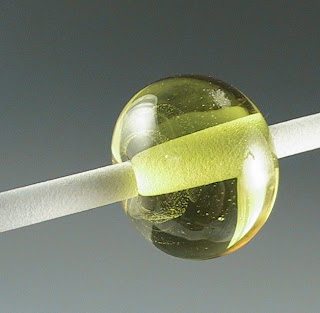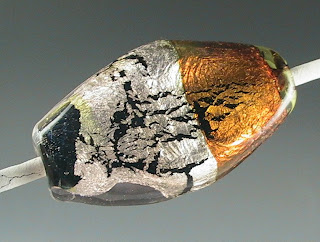Monday, November 17, 2008
Making a Dichroic Bead
Here's another little video - this one is about 8 minutes long - and shows making a dichro bead. LMK if it plays, is clear, etc. For this one, I went with brief subtitles, instead of a voice-over. Mostly, the target audience is people who know little or nothing about beadmaking - but maybe experienced beadmakers will enjoy it too.
Thursday, November 06, 2008
Further thoughts on Kelp (Mor 090)

I was just winding off a few Nyx beads last night, and encasing them in clear - and I had a thought about how reactive Kelp had been over the silver foil, and I thought - gee - most of these exotic reactive colours like the Double Helix colours are loaded with silver - what happens if I encase Nyx with Kelp?
The green bead on the left is Nyx, encased with Kelp, the blue bead on the right is Nyx, encased with clear.
I did flash them through a reducing flame, but that didn't influence the encased colours - just the unencased part by the hole.
Interesting, eh?

New Video Test
OK - trying again. This time I got the raw HDV source to play with. It's dark, but I can lighten it a little, but I thought I'd try it without. Notice the lack of the annoying pixelation in the background.
If this goes well, the thankless task of reviewing hours of video begins. Urk.
Tuesday, November 04, 2008
Mor 090 Kelp (Verde Algae)
 A big bundle of this colour emerged recently in a clean up - Moretti 090. Some websites refer to this as "Kelp" - but the original packaging refers to it as (in Italian) Verde Algae. Algae Green I can just about buy - but I've lived on the west coast - and my first thought was: "Kelp this ain't!" Kelp is a truly amazing plant - it can grow a couple of feet a day - but it tends to be more of an iridescent brown when it washes up on the beach.
A big bundle of this colour emerged recently in a clean up - Moretti 090. Some websites refer to this as "Kelp" - but the original packaging refers to it as (in Italian) Verde Algae. Algae Green I can just about buy - but I've lived on the west coast - and my first thought was: "Kelp this ain't!" Kelp is a truly amazing plant - it can grow a couple of feet a day - but it tends to be more of an iridescent brown when it washes up on the beach.However, a quick trip to Wikipedia on the topic of kelp, reveals that kelp used to be burned in quantity to produce the soda ash used in soda glass production - so there may be a connection that way. I just thought it was a faulty
 translation!
translation!Anyhoo - it's a colour that could spark arguments about whether is it more of a dirty yellow, or a very light green. It's a very organic colour - a little too green to be a real yellow, IMHO, and not really green enough to be a green. In the second pic - the two beads have trace bits of white, for a slightly cloudy effect. Upon even further contemplation - you could call it a light gold colour. Which brings us to our third picture!
This encased
 silver foil bead is Mor. Rose Quartz on the left (notice there is hardly any yellowing of the foil!!!!) and on the right, that rich golden brown, that's Kelp over silver foil! How'd ya like that! What a great colour! I'm really impressed with that! If nothing else - you're going to want to experiment with this for other cool reactions!
silver foil bead is Mor. Rose Quartz on the left (notice there is hardly any yellowing of the foil!!!!) and on the right, that rich golden brown, that's Kelp over silver foil! How'd ya like that! What a great colour! I'm really impressed with that! If nothing else - you're going to want to experiment with this for other cool reactions!
Subscribe to:
Comments (Atom)